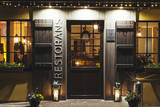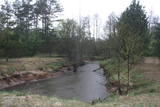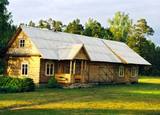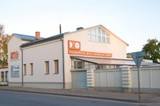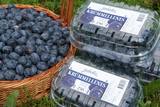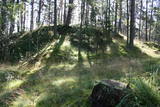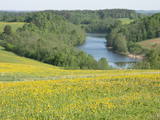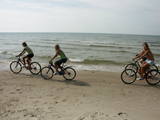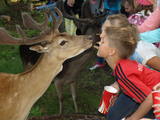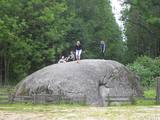| Нo | Название | Описание |
|---|---|---|
|
Небольшая, тихая и уютная гостиница с полюбившимся гурманам рестораном расположена на обочине Таллинского шоссе в Айнажи, где воздух пахнет соснами и морем. В уютной атмосфере ресторана можно не спеша насладиться вкусной едой и почувствовать близость природы. |
||
|
Nature restricted area is located to the South from former railroad Ventspils-Liepaja and includes approximately 6 km of Uzava River (and the old drainage system). The territory was used for agriculture during Soviet time, now it starts overgrow by scrubs. The protected nature values – rare bird species, including corncrakes, variety of grassland habitats and plant species. Territory is not useable for tourism activities. There is a possibility to get good insight into the North part of restricted area from the road Alsunga – Berzkalns where information stand is located.
|
||
|
Some 250 deer graze on 100 ha of land in the Umurga Parish. The farm also offers a look at peacocks, rabbits, sheep, goats and a pony. Biological products are on sale, and visitors are welcome all year round.
|
||
|
Lauku sētas atrodas pie upītes, ciema nomalē, kas jau izsenis bijusi mājvieta biškopjiem. Vieta piemērota mierīgai atpūtai. Izglītojošas nodarbības ikvienam, kas ir ieinteresēts Dzūkijas kulinārajā mantojuma, amatniecībā un tradīcijās. Maizes cepšana, pīrāgi ar sēnēm, olu rotāšana ar vasku, pinumi no salmiem. Vakarēšana ar dzuku dziesmām un dejām. Tautastērpu izgatavošana gan bērniem, gan pieaugušajiem. |
||
|
Тропа создана на склоне основного берега древней долины реки Абава, где можно осмотреть рассредоточенное выклинивание подземных вод, различные типы лугов, можжевельниковые поляны и др. На береговом склоне весь год „хозяйничают” дикие коровы. 200 ступеней приведут вас к вершине берега древней долины, с которой открывается великолепный вид. Тропу рекомендуется посещать в сопровождении местного гида. |
||
|
Крестьянское хозяйство "Берзини" начало свою деятельность в 1991 году как семейное предприятие. Питомник ориентирован на выращивание декоративных растений – однолетних и многолетних цветов. В хозяйстве имеются сезонные и двухпленочные теплицы площадью 2200 квадратных метров, на территории в 7000 квадратных метров находятся от 120 до 140 тысяч многолетних цветов, помещенных в горшки. Здесь производят рождественские товары и материалы для флористики. |
||
|
В центре работает одиннадцать гончаров, в т.ч. гончары «Школы гончаров» («Пуднику скулас»). Здесь организуются занятия, мастер-классы, демонстрация процесса работы гончара, выставлены готовые работы. Можно заказать и купить готовую продукцию. |
||
|
В красивом месте недалеко от озера Кала на склонах холмов растет малина, клубника, клюква и кустовая черника. В сезон можно собрать ягоды, приобрести и продегустировать продукцию, а также записаться на познавательную экскурсию. |
||
|
Overgrown with reeds, full of seashore meadows, lagoons, muddy little lakes and sandy shallows – this is the part of the Bay of Rīga shoreline which runs between Ainaži and Kuiviži. The Randi meadows are an important location for birds and plant life. It is a protected habitat with environmental restrictions. A bird-watching tower and nature trail have been installed so that visitors can study the meadows. The tour will take around one hour to complete. Objects are in the Northern Vidzeme Biosphere Reserve.
|
||
|
The second biggest city in Lithuania and from 1920 – 1939 - a temporary capital. The Old Town, The Town Hall (16th century), St. Peter and Pavil cathedral - basilica (15th century), Thunder building (15th century), Laisves alley, Ciurlionis Art and Devil Museum. |
||
|
Vēstures avotos pirmoreiz minēta 1483. g. Pilsētas uzplaukums bija vērojams pēc dzelzceļa uzbūvēšanas 19. gs. beigās, kad barons Korfs sadalīja un iznomāja apbūvei muižas zemi. Pilsētas tiesības Priekule ieguva 1928. g. Pilsēta smagi cieta 2. pasaules kara pēdējos mēnešos, - t.s. Kurzemes katla laikā, kuru laikā tika sagrautas 410 no 450 ēkām. Mūsdienās tā ir neliela pilsētiņa ar mazstāvu apbūvi un nesteidzīgu dzīves ritmu. |
||
|
Cecīļu dabas taka ir kājāmgājēju tūrisma maršruts, kurā ir iespēja iepazīt Amatas novada dabas objektus gar Kumadas upes, Dančupītes un Amatas upes krastu. Takas sākuma punkts ir Amatas novada Ieriķos, 1 km no kafejnīcas, degvielas uzpildes stacijas, Cecīļu dabas takas apmeklētāju centra, blakus autoservisam. Apmeklētājiem ir iespēja izbaudīt cilvēka nepārveidotu dabas ainavu – Dančupītes kanjonu, minatūru ūdenskritumu, no Kumadas upes labā krasta aplūkot iespaidīgo Cecīļu iezi un citus objektus. Taka ir marķēta. |
||
|
Недалеко от впадения речки Килминьупе находится овитое преданиями городище Троммеля – средневековое место укрепления. Оно находится в 100 м от хутора «Крауяс». Найденные здесь в 1977-м году во время археологических раскопок куски кирпича и черепки печных горшков свидетельствуют о том, что укрепление использовалось в Средневековье. Место связано с преданиями о пирате Троммеле, который здесь зарыл награбленное богатство, поэтому на дюне видно много ям, вырытых черными археологами. В предании говорится о пирате Троммеле, который со своими людьми грабил корабли в Рижском заливе от Курземского побережья до острова Роню. В древности на этом побережье стояли на якоре многие корабли, ожидавшие более благоприятного попутного ветра, чтобы обойти мыс Колка, но пират использовал его для своих корыстных целей. Он также собирал добро с погибших кораблей. Замок Троммеля был каменным. (Источник: Ройский ТИЦ) |
||
|
This nature park is located in the most distinct part of the Dagda hillocks of the Latgale highlands. Part of it is the deepest lake in the Baltic States -- Lake Drīdzis, which is 63.1 metres deep and has nine islands. Also there is Lake Otis. The loveliest views can be watched from the ancient Lettigalian castle hill that is known as Sauleskalns, and from the eastern shores of Lake Drīdzis. Accommodations are available near the lake. |
||
|
Охраняемая морская территория Нида – Перконе является одной из биологически многообразных и важных с точки зрения охраны природы морских территорий на побережье открытой части Балтийского моря – здесь находятся выдающиеся территории рифов. В период миграции территорию пересекает большинство мигрирующих пород птиц, встречающихся в Латвии. Расположенная напротив Руцавского и Ницского края территория площадью 36 703 га особенно важна для защиты большого крохаля и малой чайки. Территория частично перекрывается морской частью природного парка «Папе» и включает морскую часть территории природного парка «Бернаты».
|
||
|
Находится за Гробиньским водохранилищем на берегу реки Аланде (ул. Пиладжу, д. 3). Туристический клуб «Ога» с 1 мая 2013 года планирует здесь организацию разных связанных с жизнью викингов мероприятий, во время которых можно будет войти в образ викинга, отправиться в поход на корабле викингов (в соответствующей одежде) по реке Аланде, а также познакомиться с окрестностями, которые связаны с тематикой викингов. Рядом с поселением установлена деревянная фигура викинга с рогами (от коров, пасущихся на Витиньских лугах на берегу Лиепайского озера). |
||
|
MIGLA ir mazā alus darītava, tas ir sens saimnieka sapnis, kurš realizējies, spēkus apvienojot kopā ar jaunāko meitu. Alus garšu meklēšanā, receptūru izstrādē, kā arī novērtēšanā piedalās visa ģimene, kur īpašas alus someljē īpašības piemīt vecākajai meitai. Apvienojot visas ģimenes stiprās puses - darītāju, runātāju un garšu pazinēju un dizaina ekspertu, tapis MIGLAS alus, kas šobrīd piedzīvo savus pirmos soļus alus pasaulē un cer iepriecināt ne vienu vien alus baudītāju! Lielu daļu alus darīšanas tiek veikta ar rokām, svērti un malti graudi, rēķināts ideālais apiņu un graudu daudzums, tiek liets, pārliets un skalots. Darītava laprāt uzņem viesus degustācijām, kurās piedāvā ne tikai nogaršot alu, bet arī cienā ar pašceptu maizi un cepumiem, kā arī iepazīstina ar alus darīšanas procesu un vēsturisko Uzvaras Līdumu, kurā atrodas alus darītava. Mazais brūzis atrodas vienviet ar Ķiploku pasauli - otru ģimenes aizraušanos, tāpēc uzreiz var apskatīt divas saimniecības. |
||
|
Батарея береговой обороны № 500, находившаяся в Акменсраге, была демонтирована, а пушки с позиций были вывезены в 1955 году. Здесь располагались четыре 130-мм артсистемы, крепления основ которых следует искать в лесу, примерно в северо-восточном направлении от маяка, под основательным слоем мха, из-за чего объект трудно найти и рассмотреть. Незнающему трудно будет найти объект в природе.
|
||
|
Сейчас в просторных вольерах парка живут около 200 оленей. Рядом построена крупнейшая в Балтии сортировочная для оленей. Хозяин предлагает понаблюдать и познакомиться с животными в непосредственной близости, организуются познавательные детские лагеря, консультируют по вопросам выращивания животных. |
||
|
This territory was established to protect various kinds of rare butterflies A popular tourist destination in the Nīcgaļi forests is the great rock of Nīcgale, which is the largest rock in Latvia – a geological and geo-morphological monument of nature. The rock has a circumference of 31.1 metres, and it is 3.5 metres high, 10.5 metres long and 10.4 metres wide for a total size of 170 m3. |
||
